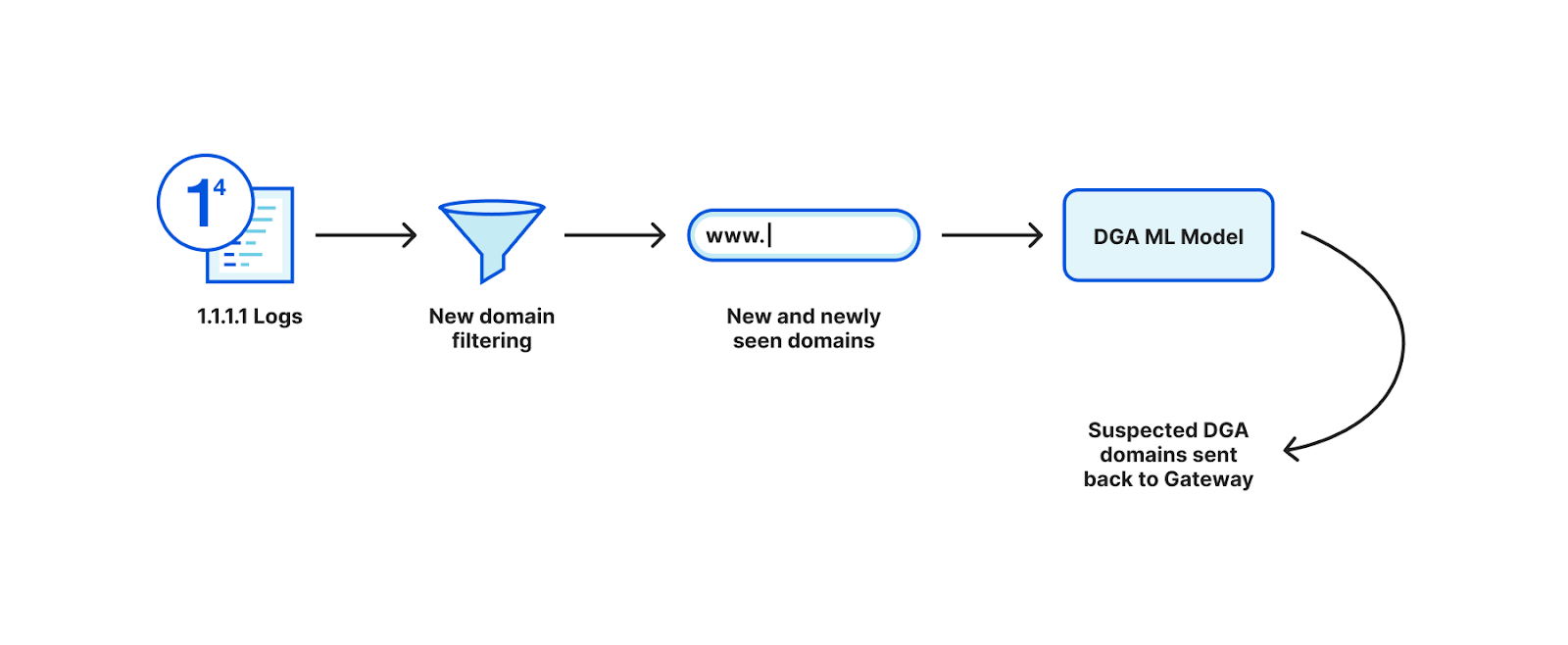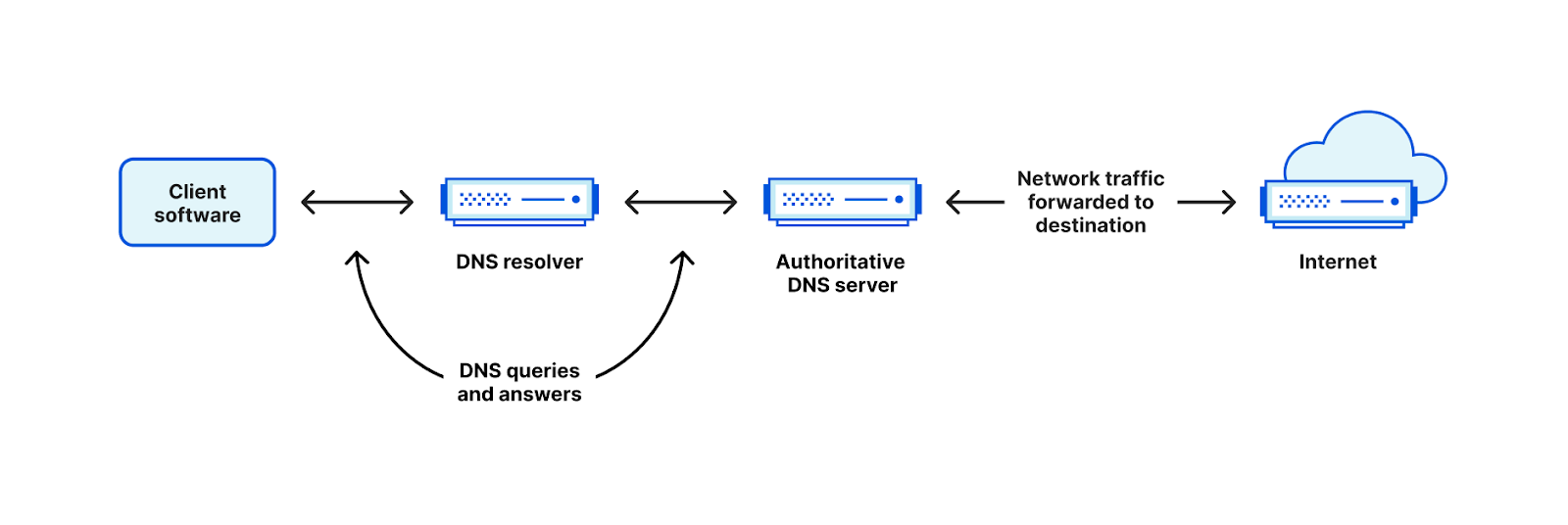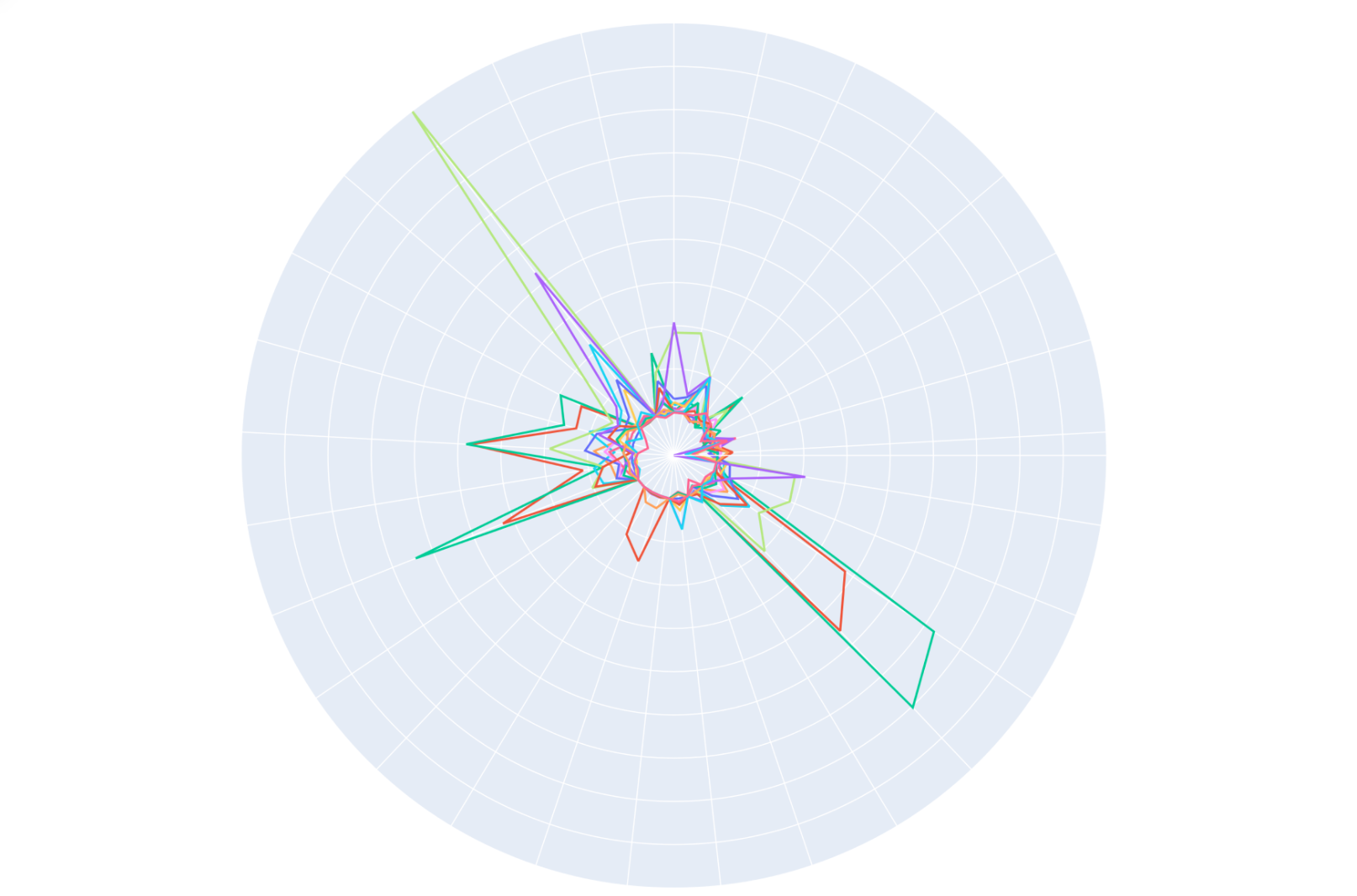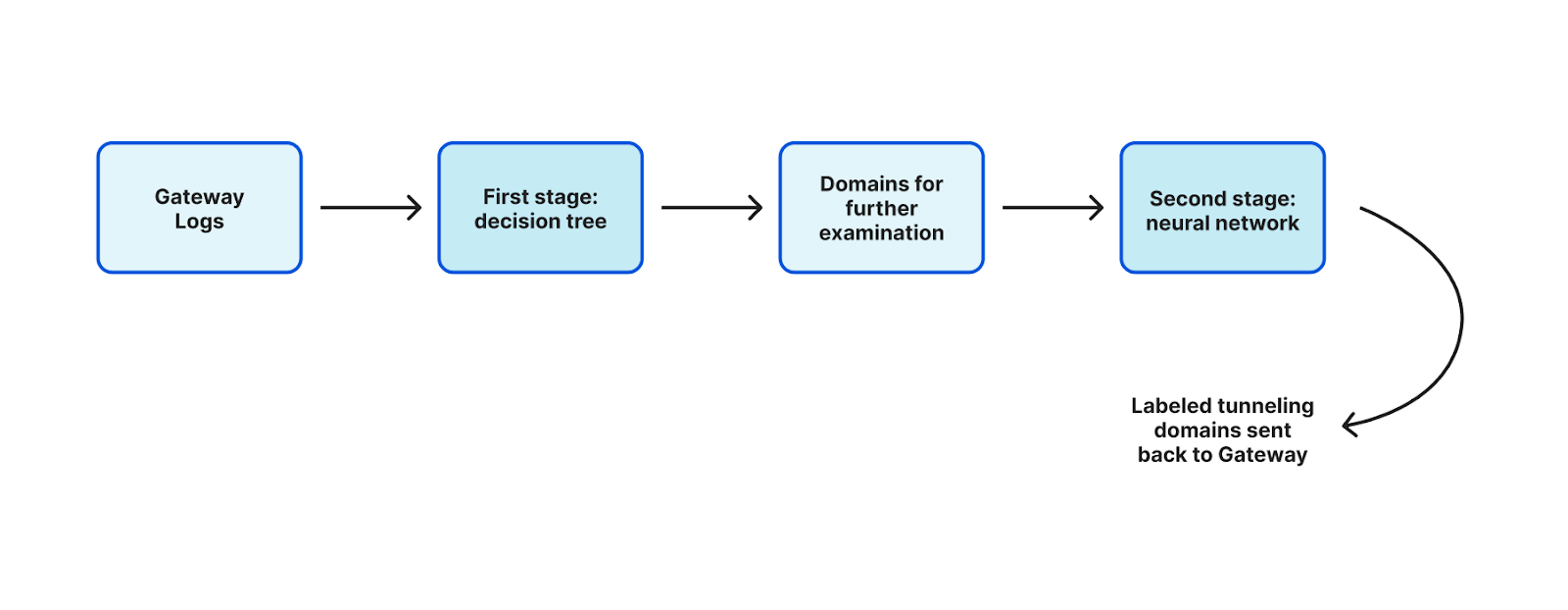
Cloudflare secures outbound Internet traffic for thousands of organizations every day, protecting users, devices, and data from threats like ransomware and phishing. One way we do this is by intelligently classifying what Internet destinations are risky using the domain name system (DNS). DNS is essential to Internet navigation because it enables users to look up addresses using human-friendly names, like cloudflare.com. For websites, this means translating a domain name into the IP address of the server that can deliver the content for that site.
However, attackers can exploit the DNS system itself, and often use techniques to evade detection and control using domain names that look like random strings. In this blog, we will discuss two techniques threat actors use – DNS tunneling and domain generation algorithms – and explain how Cloudflare uses machine learning to detect them.
Domain Generation Algorithm (DGA)
Most websites don’t change their domain name very often. This is the point after all, having a stable human-friendly name to be able to connect to a resource on the Internet. However, as a side-effect stable domain names become a point of control, allowing network administrators to use restrictions on domain names to enforce policies, for example blocking access to malicious websites. Cloudflare Gateway – our secure web gateway service for threat defense – makes this easy to do by allowing administrators to block risky and suspicious domains based on integrated threat intelligence.
But what if instead of using a stable domain name, an attacker targeting your users generated random domain names to communicate with, making it more difficult to know in advance what domains to block? This is the idea of Domain Generation Algorithm domains (MITRE ATT&CK technique T1568.002).
After initial installation, malware reaches out to a command-and-control server to receive further instructions, this is called “command and control” (MITRE ATT&CK tactic TA0011). The attacker may send instructions to perform such actions as gathering and transmitting information about the infected device, downloading additional stages of malware, stealing credentials and private data and sending it to the server, or operating as a bot within a network to perform denial-of-service attacks. Using a domain generation algorithm to frequently generate random domain names to communicate with for command and control gives malware a way to bypass blocks on fixed domains or IP addresses. Each day the malware generates a random set of domain names. To rendezvous with the malware, the attacker registers one of these domain names and awaits communication from the infected device.
Speed in identifying these domains is important to disrupting an attack. Because the domains rotate each day, by the time the malicious disposition of a domain propagates through the cybersecurity community, the malware may have rotated to a new domain name. However, the random nature of these domain names (they are literally a random string of letters!) also gives us an opportunity to detect them using machine learning.
The machine learning model
To identify DGA domains, we trained a model that extends a pre-trained transformers-based neural network. Transformers-based neural networks are the state-of-the-art technique in natural language processing, and underlie large language models and services like ChatGPT. They are trained by using adjacent words and context around a word or character to “learn” what is likely to come next.
Domain names largely contain words and abbreviations that are meaningful in human language. Looking at the top domains on Cloudflare Radar, we see that they are largely composed of words and common abbreviations, “face” and “book” for example, or “cloud” and “flare”. This makes the knowledge of human language encoded in transformer models a powerful tool for detecting random domain names.
For DGA models, we curated ground truth data that consisted of domain names observed from Cloudflare’s 1.1.1.1 DNS resolver for the negative class, and we used domain names from known domain generation algorithms for the positive class (all uses of DNS resolver data is completed in accordance with our privacy commitments).
Our final training set contained over 250,000 domain names, and was weighted to include more negative (not DGA domains) than positive cases. We trained three different versions of the model with different architectures: LSTM (Long Short-Term Memory Neural Network), LightGBM (binary classification), and a transformer-based model. We selected the transformer based model based on it having the highest accuracy and F1 score (the F1 score is a measure of model fit that penalizes having very different precision and recall, on an imbalanced data set the highest accuracy model might be the one that predicts everything either true or false, not what we want!), with an accuracy of over 99% on the test data.
To compute the score for a new domain never seen before by the model, the domain name is tokenized (i.e. broken up into individual components, in this case characters), and the sequence of characters are passed to the model. The transformers Python package from Hugging Face makes it easy to use these types of models for a variety of applications. The library supports summarization, question answering, translation, text generation, classification, and more. In this case we use sequence classification, together with a model that was customized for this task. The output of the model is a score indicating the chance that the domain was generated by a domain generation algorithm. If the score is over our threshold, we label the domain and a domain generation algorithm domain.
Deployment
The expansive view of domain names Cloudflare has from our 1.1.1.1 resolver means we can quickly observe DGA domains after they become active. We process all DNS query names that successfully resolve using this model, so a single successful resolution of the domain name anywhere in Cloudflare’s public resolver network can be detected.
From the queries observed on 1.1.1.1, we filter down first to new and newly seen domain names. We then apply our DGA classifier to the new and newly seen domain names, allowing us to detect activated command and control domains as soon as they are observed anywhere in the world by the 1.1.1.1 resolver.

DNS Tunneling detection
In issuing commands or extracting data from an installed piece of malware, attackers seek to avoid detection. One way to send data and bypass traditional detection methods is to encode data within another protocol. When the attacker controls the authoritative name server for a domain, information can be encoded as DNS queries and responses. Instead of making a DNS query for a simple domain name, such as www.cloudflare.com, and getting a response like 104.16.124.96, attackers can send and receive long DNS queries and responses that contain encoded data.
Here is an example query made by an application performing DNS tunneling (query shortened and partially redacted):
3rroeuvx6bkvfwq7dvruh7adpxzmm3zfyi244myk4gmswch4lcwmkvtqq2cryyi.qrsptavsqmschy2zeghydiff4ogvcacaabc3mpya2baacabqtqcaa2iaaaaocjb.br1ns.example.com
The response data to a query like the one above can vary in length based on the response record type the server uses and the recursive DNS resolvers in the path. Generally, it is at most 255 characters per response record and looks like a random string of characters.
| TXT | jdqjtv64k2w4iudbe6b7t2abgubis |
This ability to take an arbitrary set of bytes and send it to the server as a DNS query and receive a response in the answer data creates a bi-directional communication channel that can be used to transmit any data. The malware running on the infected host encodes the data it wants to transmit as a DNS query name and the infected host sends the DNS query to its resolver.
Since this query is not a true hostname, but actually encodes some data the malware wishes to transmit, the query is very likely to be unique, and is passed on to the authoritative DNS server for that domain.
The authoritative DNS server decodes the query back into the original data, and if necessary can transmit it elsewhere on the Internet. Responses go back the other direction, the response data is encoded as a query response (for example a TXT record) and sent back to the malware running on the infected host.

One challenge with identifying this type of traffic, however, is that there are also many benign applications that use the DNS system to encode or transmit data as well. An example of a query that was classified as not DNS tunneling:
00641f74-8518-4f03-adc2-792a34ea2612.bbbb.example.com
As humans, we can see that the leading portion of this DNS query is a UUID. Queries like this are often used by security and monitoring applications and network appliances to check in. The leading portion of the query might be the unique id of the device or installation that is performing the check-in.
During the research and training phase our researchers identified a wide variety of different applications that use a large number of random looking DNS queries. Some examples of this include subdomains of content delivery networks, video streaming, advertising and tracking, security appliances, as well as DNS tunneling. Our researchers investigated and labeled many of these domains, and while doing so, identified features that can be used to distinguish between benign applications and true DNS tunneling.
The model
For this application, we trained a two-stage model. The first stage makes quick yes/no decisions about whether the domain might be a DNS tunneling domain. The second stage of the model makes finer-grained distinctions between legitimate domains that have large numbers of subdomains, such as security appliances or AV false-positive control, and malicious DNS tunneling.
The first stage is a gradient boosted decision tree that gives us an initial classification based on minimal information. A decision tree model is like playing 20 questions – each layer of the decision tree asks a yes or no question, which gets you closer to the final answer. Decision tree models are good at both predicting binary yes/no results as well as incorporating binary or nominal attributes into a prediction, and are fast and lightweight to execute, making them a good fit for this application. Gradient boosting is a reliable technique for training models that is particularly good at combining several attributes with weak predictive power into a strong predictor. It can be used to train multiple types of models including decision trees as well as numeric predictions.
If the first stage classifies the domain as “yes, potential DNS tunneling”, it is checked against the second stage, which incorporates data observed from Cloudflare’s 1.1.1.1 DNS resolver. This second model is a neural network model and refines the categorization of the first, in order to distinguish legitimate applications.
In this model, the neural network takes 28 features as input and classifies the domain into one of 17 applications, such as DNS tunneling, IT appliance beacons, or email delivery and spam related. Figure 2 shows a diagram generated from the popular Python software package Keras showing the layers of this neural network. We see the 28 input features at the top layer and at the bottom layer, the 17 output values indicating the prediction value for each type of application. This neural network is very small, having about 2,000 individual weights that can be set during the training process. In the next section we will see an example of a model that is based on a state-of-the-art pretrained model from a model family that has tens to hundreds of millions of predefined weights.

Fig. 2, The keras.utils.plot_model() function draws a diagram of the neural network layers.
Figure 3 shows a plot of the feature values of the applications we are trying to distinguish in polar coordinates. Each color is the feature values of all the domains the model classified as a single type of application over a sample period. The position around the circle (theta) is the feature, and the distance from the center (rho) is the value of that feature. We can see how many of the applications have similar feature values.
When we observe a new domain and compute its feature values, our model uses those feature values to give us a prediction about which application the new domain resembles. As mentioned, the neural network has 28 inputs each of which is the value for a single feature and 17 outputs. The 17 output values represent the prediction that the domain is each of those 17 different types of applications, with malicious DNS tunneling being one of the 17 outputs. The job of the model is to convert the sometimes small differences between the feature values into a prediction. If the value of the malicious DNS tunneling output of the neural network is higher than the other outputs, the domain is labeled as a security threat.

Fig. 3, Domains containing high-entropy DNS subdomains, visualized as feature plots. Each section around the circumference of the plot represents a different feature of the observed DNS queries. The distance from the center represents the value of that feature. Each color line is a distinct application, and machine learning helps us distinguish between these and classify them.
Deployment
For the DNS tunneling model, our system consumes the logs from our secure web gateway service. The first stage model is applied to all DNS queries. Domains that are flagged as possible DNS tunneling are then sent to the second stage where the prediction is refined using additional features.

Looking forward: combining machine learning with human expertise
In September 2022, Cloudflare announced the general availability of our threat operations and research team, Cloudforce One, which allows our in-house experts to share insights directly with customers. Layering this human element on top of the ML models that we have already developed helps Cloudflare deliver additional protection threat protection for our customers, as we plan to explain in the next article in this blog series.
Until then, click here to create a free account, with no time limit for up to 50 users, and point just your DNS traffic, or all traffic (layers 4 to 7), to Cloudflare to protect your team, devices, and data with machine learning-driven threat defense.

